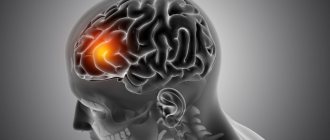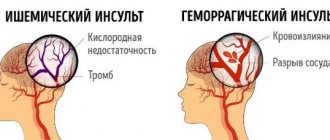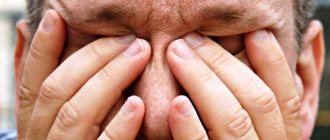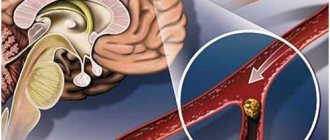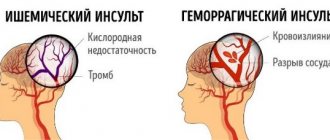What is a stroke and why is it dangerous?
Stroke is a circulatory disorder in the brain [1]. It can occur due to a ruptured vessel or blockage by a blood clot. In this case, the nerve cells do not receive the required amount of oxygen, glucose and other nutrients, which can lead to their death.
There are several factors that increase the risk of stroke, including: excess weight, high cholesterol, diabetes, hypertension, alcohol and drug use, and smoking. In addition, doctors take into account genetic predisposition and age: the disease most often affects those over 45 years old.
Stroke can be ischemic or hemorrhagic. Subarachnoid hemorrhage is also isolated, which is rare, but in 50% of cases is accompanied by death. He is characterized by acute pain in the back of the head, convulsions, vomiting and loss of consciousness are possible.
Ischemic stroke, or cerebral infarction, is the most common type of cerebrovascular accident. The immediate cause of ischemic stroke is blockage of a vessel supplying the brain. This may occur due to the formation of a blood clot or its entry into the lumen of the vessel. People with atherosclerosis, cardiac arrhythmias, or heart valve disease have an increased risk of developing blood clots. Ischemic stroke can occur when you take medications on your own without a doctor's prescription (for example, diuretics or combined oral contraceptives).
Symptoms of an ischemic stroke develop over a short period of time and are not accompanied by headaches, since there are no pain receptors in the brain. Most often this happens at night when a person is sleeping, and in the morning when waking up he discovers that an arm or leg is not working or speech is impaired.
In a hemorrhagic stroke, the wall of a vessel ruptures and blood permeates the brain tissue. Frequent causes of hemorrhagic stroke are increased blood pressure, taking drugs that reduce blood clotting, disruption of the structure of the vessel wall (aneurysm) or congenital abnormalities of the vascular bed - arteriovenous malformations. Hemorrhagic stroke develops quickly and is often accompanied by headache. If blood soaks into the choroid of the brain, where there are pain receptors, a person may lose consciousness. This subtype of stroke has a high rate of death, but if the person survives, he recovers well.
First aid for stroke
It is advisable that a person with a stroke be taken to hospital as soon as possible - within three hours of the onset of the first symptoms. Therefore, it is important to properly organize assistance for a person with suspected stroke.
- Call an ambulance. If you experience symptoms of a stroke, ask for help and have someone else call the doctor. Provide brief information about the patient (age, what happened). Leave your contact information so we can contact you. Be prepared to meet the physician and provide access to the patient.
- Help the patient find a safe position: it is best to lie on his side with his head slightly elevated.
- While you are waiting for an ambulance, try to find out from the patient when the symptoms began, what chronic diseases does he suffer from and what medications does he take? This information will save doctors time and allow them to quickly make decisions.
- If a person is unconscious and not breathing, cardiopulmonary resuscitation must be performed. However, to properly provide it, it is necessary to undergo specialized training courses [2], [3].
- If the patient has difficulty breathing, remove restrictive clothing (tight collar, tie or scarf) and open the windows.
- If a person is cold, cover him with a warm blanket.
- While the ambulance is traveling, do not under any circumstances try to give the patient something to drink, feed, or force him to stand up. The person may have difficulty swallowing and may choke. And when trying to stand up due to high blood pressure or lack of coordination, there is a high risk of falling and receiving additional injuries.
- Monitor the person closely for any changes in their condition. Be prepared to tell the emergency operator or doctor about their symptoms and when they started. Be sure to indicate whether the person fell or hit their head.
- In some cases, it is advisable to transport the patient to the nearest hospital yourself if you are not confident in the efficiency of the team. Discuss this decision with the emergency operator.
It is good if several people provide assistance. For example, one will be responsible for resuscitation, the second will monitor pulse and blood pressure, and the third will talk on the phone with doctors. Call neighbors and others for help if the sick person is on the street or in a public institution.
Signs and symptoms of stroke
Depending on the severity of the stroke, symptoms may be mild or severe. You need to know what to look for. To check for warning signs of a stroke, you can use the Western mnemonic FAST, which means [4]:
F - face - “face”
A - arm - “hand”
S - speech - “speech”
T - time - “time”
The first symptom is facial asymmetry. If you ask a person to smile, he will not be able to do it; one corner of his mouth will remain downturned. When the patient sticks out his tongue, it may deviate to one side. As soon as you have performed a small operational test, you must immediately call an ambulance. Often the victim does not respond to requests, cannot speak coherently and cannot raise both hands at the same time; sometimes he is in a state of disorientation, the pupils are dilated or there is no reaction to light.
Transient ischemic attack can be difficult to identify based on symptoms alone [5]. They resolve completely within 24 hours and often last less than five minutes. The attack causes temporary circulatory failure and may be followed by a more severe stroke, so it is important to see a doctor as soon as possible.
However, it is worth remembering that only a small part of the brain is responsible for movement and sensitivity, therefore, if blood circulation is disrupted in other parts of the brain, a variety of symptoms may occur: impaired speech, swallowing, vision, dizziness, lack of coordination, confusion and loss of consciousness, epileptic seizures, sudden memory loss or inappropriate behavior of the patient and others. The main task is to call a doctor if someone feels unwell: unusual symptoms appear that were not there before. It’s better to be on the safe side than to miss time, which is the most important factor determining the prognosis for a stroke.
Duel with illness. Is it possible to recover after a stroke?
A stroke always leaves an indelible mark on the life of a person who has suffered a brain stroke. Most patients experience loss of movement in their limbs after a stroke. But even in the most severe cases, do not despair: the body has great self-healing capabilities. Knowing this and the patient’s great desire to return to a full life, as well as the help of loved ones help to overcome the disease. That is why doctors pay special attention to the rehabilitation period after a stroke.
We asked rehabilitation specialist, Candidate of Medical Sciences Elena Vasilyevna LITVINOVA (Nizhny Novgorod) to tell us more about recovery methods.
— After a stroke, consequences are inevitable. How pronounced are they?
— It is almost impossible to accurately predict the consequences of a stroke in advance. Less than 20% of patients return to a full life.
One of the most dangerous complications of a stroke is impaired movement in the form of paresis (decreased range of motion and muscle strength) and paralysis (complete lack of movement). Therefore, rehabilitation measures for patients should begin in the first days after suffering a brain stroke.
— What determines the degree and time of restoration of impaired functions?
— There are two main causes of cerebrovascular accident: hemorrhage in the brain as a result of a rupture of the vessel wall (hemorrhagic stroke) and blockage of the lumen of the vessel by a thrombus or atherosclerotic plaque (ischemic stroke). In both cases, some area of brain tissue dies, deprived of the flow of fresh blood. And around this focus there is a zone of neurons (nerve cells), which balances between life and death. So these neurons can be brought back to life by sending them a stream of motor impulses. When a patient after a stroke begins rehabilitation measures, these neurons begin to come to life, other parts of the brain are connected, which take on the lost functions of the dead area. After a hemorrhagic stroke (more severe), the quality of recovery may be even better than after an ischemic injury, since the zone of inactivated neurons (ready for recovery) in the first case is much larger.
— During a stroke, does only one half of the body suffer or both?
— If a circulatory disorder occurs in the right hemisphere of the brain, then the left half of the body suffers. In case of a catastrophe in the left hemisphere, the same phenomena are observed on the right. Sometimes the part of the brain that controls the movements of the entire body dies, but this happens rarely.
— How can relatives help the patient in his recovery?
— Relatives bear great responsibility for the health of the patient; at this time, maximum perseverance, attention, and patience are required from them, since relatives have to scrupulously follow all the doctor’s recommendations.
What should you do at first?
* It is necessary to turn the patient on one side or the other every 2 hours.
* Several times a day you can perform a light back massage (stroking, rubbing) to avoid congestion, primarily in the lungs.
* For better lung function, every 2 hours, if possible, the patient should take 2-3 deep breaths.
* In the morning and evening, the patient should be washed with warm water and shampoo.
* It is necessary to ensure the prevention of bedsores (an inflatable rubber circle 1-2 cm high is placed under the sacrum, cotton-gauze 'bags' are placed under the heels, etc.).
* In case of pathology in the veins, it is advisable to bandage the patient’s legs for several hours to avoid stagnation of blood in the lower extremities.
* It is better to position the patient’s bed so that the affected part of the body is located on the side of the source of irritation (door, TV, etc.). This will stimulate movement in the affected limbs.
* It is advisable for patients to lie on both sides and carry out the so-called “position treatment” several times a day.
After a stroke, the muscles are initially in a relaxed state, and then their tone begins to increase. The sore arm seems to be “shortened”: the shoulder is brought to the body, the hand and fingers are bent, and the sore leg seems to “lengthen”: the lower leg is extended at the knee joint, and the foot is in the position of plantar flexion (“dangling”). When walking, patients usually move their leg to the side and move it in a circle (“move”).
To restore correct movements from the first days after a stroke and throughout the entire rehabilitation period, positional treatment, passive and active gymnastics, breathing exercises and other methods of combating the disease are carried out.
The most effective treatment lasts for the first 3-6 months. There are 3 stages of recovery after a stroke: the early period is up to 3 months, the late period is up to a year, and after a year residual impairments in motor functions are compensated.
— Do medications help with muscle spasms?
— There is a whole group of muscle relaxant drugs that act on spastic (spasmodic) muscles. But these drugs should not be abused. The fact is that it is undesirable to completely relieve muscle spasms, since in some cases, with incomplete restoration of movements, normalization of tone in the leg can lead to a decrease in its supporting function. As a result, the person will find it difficult to walk.
Rehabilitation treatment includes a complex of different methods: physiotherapy, physical rehabilitation, acupuncture, swimming pool exercises and much more. Patients feel great benefits from performing ideomotor exercises that are done mentally. In case of paralysis and deep paresis, the victim is shown what movements are possible in the joints and is asked to mentally perform exercises with each affected limb at least 4 times a day for 15 minutes. By the way, Valentin Ivanovich Dikul began his recovery with exercises performed mentally. The conducted studies confirm the fact that when using ideomotor exercises, the patient’s rehabilitation is more effective.
We must not forget about healthy muscles, which also need to be trained. The better a healthy limb works, the faster the recovery in the affected part of the body.
Evgenia NIKOLAEVA.
Diagnostics
After examining the patient and studying the medical history, a magnetic resonance or computed tomography scan of the brain is performed. Such research is necessary because the symptoms of stroke can be similar to those of meningitis, brain abscess and many other diseases.
After the research, the type of stroke is determined and the most appropriate treatment methods are selected.
By the way
It is advisable to have glycine in your home medicine cabinet. Many doctors consider this drug a neuroprotector, that is, a substance that protects brain tissue.
If you experience unpleasant sensations (primarily weakness) that first appear in your arm or leg, or speech disorder, you should put 5 glycine tablets under your tongue. With the help of such prevention, it is possible to prevent brain damage to some extent.
What is a microstroke
This word refers to temporary disorders of cerebral circulation that last less than one day. Doctors call such small foci of cerebral ischemia lacunar.
The origin of microstrokes is associated with changes in the walls and blockage of very small arteries located deep in the brain.
If a lacunar stroke affects an area where there are no critical nerve pathways, then adverse symptoms can be avoided. But, gradually accumulating, microstrokes impair memory, attention, and balance when walking.
If a lacunar stroke develops in an area where important pathways from the brain to the spinal cord are concentrated, then the consequences will be very severe. In this case, a sign of a stroke may be muscle weakness in an arm or leg.
Focus on health
After a stroke, it is imperative to lead a healthy lifestyle: stop smoking and drinking alcohol, switch to an anti-sclerotic diet, and engage in feasible physical activity.
Nicotine worsens the prognosis of the disease and significantly increases the likelihood of a recurrent stroke.
You need to eat foods with low cholesterol. This means that you cannot eat a lot of animal fats, which are found in butter, mayonnaise, fatty cheeses, cottage cheese, fatty pork, lard, and chicken eggs (you can eat no more than two of these per week).
It is recommended to increase the amount of vegetables, fruits and vegetable oils in the diet. It is believed that vegetable oils together with vegetables reduce cholesterol levels in the blood.
The amount of salt in the diet should be reduced, as it retains fluid in the body and increases blood pressure.
Physical education classes are carried out under the control of blood pressure: during exercise, the upper pressure figure should not be higher than 180-200.
What is a stroke
The essence of a stroke is the cessation of blood supply and functioning of a part of the brain as a result of damage to a vessel.
The larger the affected area, the more severe the stroke. Necrosis of a portion of the brain substance is called an infarction [3]. There is a high risk of death in the first few hours, and then in the period up to 28 days after a vascular accident. The annual mortality rate from stroke in the Russian Federation is 374 cases per 100,000 [10]. In 2018, 35% of patients died in the acute period of stroke; by the end of the first year, this figure increases by 15%, and in general, in the first 5 years, the mortality rate of strokes is 44% [11]. The mortality rate from stroke was 92.9 per 100,000 population, and the hospital mortality rate was 19.1% [5].
Long-term disability is most likely for patients who have suffered a stroke. The prevalence of primary disability due to stroke in 2018 was 3.2 per 10 thousand population [2]. Of these, 31% need constant care, 20% have severe mobility limitations, and only 8% return to work [3]. The prevalence of recurrent strokes in 2014 was 0.79%, of which ischemic
strokes account for 87.5% [9].
Stroke treatment
Treatment of stroke is regulated by relevant clinical guidelines and the Procedure for providing medical care to patients with acute cerebrovascular accident. In the first hours, thrombolytic therapy is carried out and subsequently - prevention of thrombus formation. For hemorrhagic stroke, neurosurgery may be performed. They normalize blood pressure, water-electrolyte balance, glucose levels in peripheral blood and urine, support the basic vital functions of the body and prevent complications. Drug therapy is also aimed at improving the affected functions of the nervous system [1, 3, 6].
Relevance
Extracranial carotid and vertebral artery dissections are an important cause of stroke, especially in younger individuals.
Some observational studies suggest that these individuals have an increased risk of stroke recurrence. Antiplatelet agents and anticoagulants are used to reduce the risk of stroke, but which strategy is preferable in patients after cervical artery dissection is not known.
A group of researchers compared the effectiveness of an antiplatelet agent and an anticoagulant in preventing stroke after cervical artery dissection and the risk of recurrent stroke.
Symptoms of a stroke
Stroke leads to various brain injuries, depending on the location of the lesion and the pathological type of cerebrovascular accident:
- disturbances of movement in the limbs: from restrictions (paresis) to complete paralysis. When the lesion is localized on the right, the left limbs suffer; with a left-sided lesion, right hemiparesis is formed; in some cases, movements in all limbs may stop (tetraparesis or double hemiparesis);
- sensory disturbances on one or both sides;
- speech disorders (dysarthria - poor articulation; aphasia - inability to pronounce and understand words, write and read);
- ataxia (impaired coordination of movements, “overshooting”, unsteadiness, imbalance, tremor);
- visual impairment: from blindness to double vision and gaze paresis;
- hearing impairment and dizziness;
- violation of mental functions (consciousness, thinking, attention, memory, will, behavior);
- paresis of the soft palate and pharynx, swallowing disorders;
- disorders of urination and defecation;
- depression of respiration and vascular tone;
- increased intracranial pressure;
- patients complain of headaches, vomiting, hiccups, yawning, shoulder pain;
- consciousness is gradually depressed to the point of coma [1, 3].
Causes of death may include cerebral edema, pneumonia, heart failure, and recurrent stroke. In severe cases, “locked-in syndrome” may develop: the patient is conscious, but cannot move, swallow or speak [3].
Diagnosis of strokes
First of all, it is necessary to conduct a detailed neurological examination. Instrumental diagnostic studies and laboratory tests are also prescribed. In case of a stroke, in the first hours, an MRI or CT scan of the brain is performed, if necessary, CT or MR angiography, color Doppler mapping of blood flow, ECG or Holter monitoring, echocardiography as indicated, monitoring of blood pressure, saturation, assessment of the risk of developing bedsores, assessment of swallowing function [ 1, 3, 6].
Tests for stroke
- Complete clinical blood test, including erythrocyte sedimentation rate (ESR).
- Biochemical blood test with determination of C-reactive protein and homocysteine, glucose level, platelet count, activated partial thromboplastin time, INR.
- Interleukin 10.
- Extended coagulogram.
- Determination of acid-base status.
- General urine analysis.
To prepare for neurosurgical intervention, a blood test is additionally performed for hepatitis, syphilis, HIV, blood group and Rh factor determination.
Consequences of a stroke
There are transient ischemic attack (less than a day), minor stroke (from 1 day to 3 weeks) and stroke with persistent residual effects. The consequences of a stroke are expressed mainly in motor and sensory disorders, the formation of muscle contractures (pronounced constant restriction of movements in the joints), speech and swallowing disorders. General symptoms may also remain, including confusion, disturbances in thinking, will, and emotional regulation. Complications can develop: from epilepsy to bedsores, encephalopathy and anxiety-depressive syndrome [1, 3].

